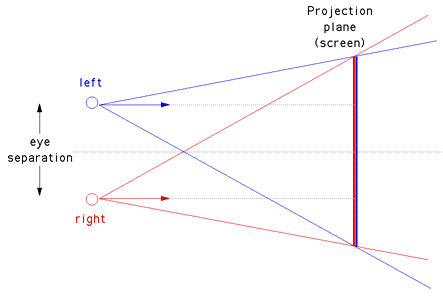I've been a little bored while waiting for the parts and tools to come in for my January project. After playing Fez and trying out the stereoscopy mode, I decided to pass the time by trying to add the feature to my 3D cube.
Stereoscopy works by creating two cameras, one for the right eye and one for the left. These two cameras are a small distance apart. Each of them will see a slight different image/projection of the 3D objects. An image from anSGI tutorial written by Paul Bourke gives a great visualization:

There are multiple ways to view the right and left images. Probably the most common is the use of red and cyan filters. Though systems like the RealD 3D use polarized light to achieve this effect. The first method has significant color quality loss on images, where as the later has much less loss. The reason why the first method is much more prevalent is that it is much cheaper and easier to do. E.g., it doesn't require any extra equipment (sans the glasses) and is not to difficult to implement. Systems like Nintendo's 3DS use a phenomenon known as Autosteroscopy that doesn't require glasses, this is achieved by having Lenticular Lenses applied to the display. It's pretty nifty, and the quality isn't too bad, but there is there are the slight problems that it is more expensive and the viewer need to be in a “sweet spot,” to see the 3D image.
I decided to go with the red/cyan image method. In the current state of my 3D cube program, I don't have anything complicated like cameras added in, so to get this working I did this:
p = a perspective projected line
q = an oblique projection on p,
with theta = PI / 180, and a small skew value on the x component
r = an oblique projection on p,
with theta = PI, and a small skew value on the x component
color q with blue
color r with red
draw q
draw r
It's definitely an improper method, NEVER DO THIS, but it does give off the effect. I updated the repo page in case you want to view the source. Just change the variable renderStereo to be true.
Below is the stereo-scoped 3D cube (as JavaScript)
